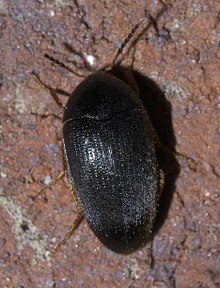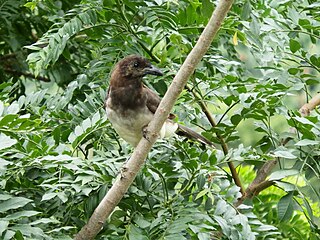
The brown jay is a large jay native to North and Central America.

Eucinetidae is a family of beetles, notable for their large coxal plates that cover much of the first ventrite of the abdomen, sometimes called plate-thigh beetles. The family is small for beetles, with about 50 species in 11 genera, but are found worldwide.

Anacamptis morio, the green-winged orchid or green-veined orchid, is a flowering plant of the orchid family, Orchidaceae. It usually has purple flowers, and is found in Europe and the Middle East.

Zophobas morio is a species of darkling beetle, whose larvae are known by the common name superworm, kingworm, morio worm or simply Zophobas. Superworms are common in the reptile pet industry as food, along with giant mealworms, which are Tenebrio molitor larvae sprayed with juvenile hormone.
Haydon Meadow known locally as Clifford Meadow is a 6.39 hectare biological Site of Special Scientific Interest in Wiltshire, notified in 1999.

The chocolate wattled bat is a bat in the family Vespertilionidae. It is found only in Australia, including the island Tasmania, and widespread in southern regions. It is known to reside from sea level to at least 1,570 metres (5,150 ft) in Victoria.

The Lord Howe long-eared bat was a vespertilionid bat known only by a single specimen, a skull found on Lord Howe Island in 1972. A mammalian insectivorous species resembling the long-eared Nyctophilus, with an elongated head that is comparatively larger, about which almost nothing is known. The bat may have been casually observed in flight during the twentieth century, but is likely to have become extinct since the island's discovery and occupation. The demise of N. howensis is possibly the result of shipwrecked rats and the owls introduced to control them.
The Cameroon soft-furred mouse or Cameroon praomys is a species of rodent in the family Muridae. It is found in Cameroon and Equatorial Guinea. Its natural habitat is subtropical or tropical moist montane forests. It is threatened by habitat loss.

The Mount Cameroon forest shrew or arrogant shrew, is a species of mammal in the family Soricidae endemic to Cameroon. Its natural habitat is subtropical or tropical moist montane forests.
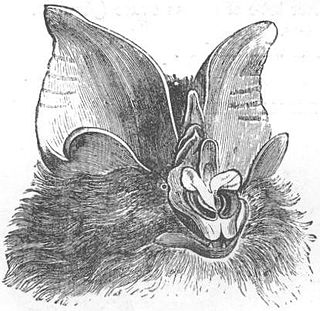
The great woolly horseshoe bat is a species of bat in the family Rhinolophidae.
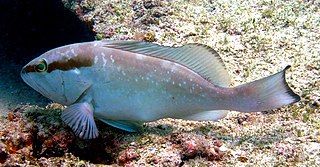
The red grouper is a species of marine ray-finned fish, a grouper from the subfamily Epinephelinae which is part of the family Serranidae, which also includes the anthias and sea basses. It is found in the western Atlantic Ocean.

Mitopus morio is a species of harvestman arachnid belonging to the family Phalangiidae.
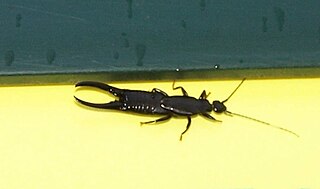
Chelisoches morio, the black earwig, is a species of insect in the family Chelisochidae. It is an omnivore that can be found worldwide, however it is most prominent in tropical areas, Pacific islands, the Pacific Northwest, and damp environments. The adults are jet black and can range in size from 18 to 25mm in size, though some have grown to be 36mm. The males cerci are widely separated and serrated compared to the female. The forceps are used for prey capture, defense, fighting and courtship.

Bombus morio is one of the few bumblebee species found in South America. These bees reside mainly in the forests of Brazil, nesting on the surface of the ground. They are one of the biggest species of bumblebee and are important pollinators. They are one of the few species of bees that exhibit buzz pollination to collect pollen from the flowers.
Aplysia morio, the Atlantic black sea hare or sooty sea hare, is a species of sea slug, a marine gastropod mollusk in the family Aplysiidae, the sea hares. It lives in warm waters in the Caribbean Sea and off the south and southeastern coast of the United States, where it feeds on seaweed.

Hyalopsocus is a genus of common barklice in the family Psocidae. There are about six described species in Hyalopsocus.

Irbisia is a genus of plant bugs in the family Miridae. There are more than 20 described species in Irbisia. These black insects are 5–8 mm in length. They are also called black grass bugs as they are common in spring grasses.
Hydroporus morio is a species of predaceous diving beetle in the family Dytiscidae. It is found in Europe and Northern Asia and North America.
Criocoris is a genus of plant bugs in the family Miridae. There are about 13 described species in Criocoris.

Eucinetus is a genus of plate-thigh beetles in the family Eucinetidae. There are at least four described species in Eucinetus.
